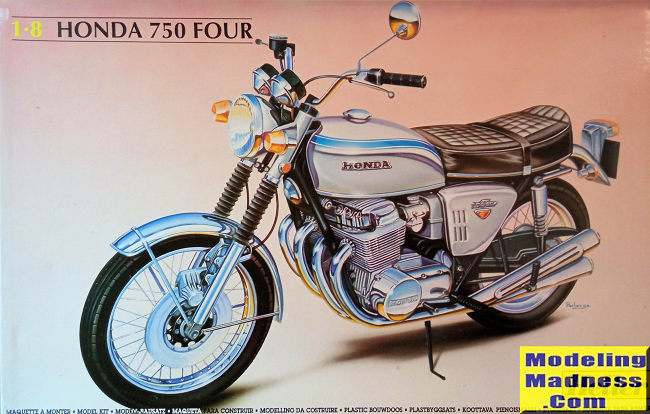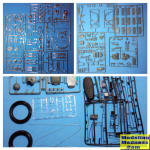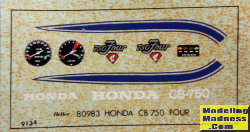
Heller 1/8 Honda CB750K1
| KIT #: | 80983 |
| PRICE: | €15 when new |
| DECALS: | One option |
| REVIEWER: | Spiros Pendedekas |
| NOTES: | 1971 release |

| HISTORY |
The CB750, the first motorcycle to be called a "superbike" and often called the
original Universal Japanese Motorcycle (UJM), is an air-cooled, transverse,
in-line four-cylinder engine motorcycle with an upright or “standard” riding
posture, that was made by Honda over several generations for year models
1969–2003, as well as 2007.
Though the specific power plant type had been used in racing prior to World War
II and already marketed by other manufacturers, it was Honda that popularized it
with the CB750, subsequently becoming the dominant sport bike engine layout.
The iconic CB750 was named in the Discovery Channel's "Greatest Motorbikes Ever"
and was in The Art of the Motorcycle exhibition. It is in the UK National Motor
Museum and is included in the AMA Motorcycle Hall of Fame Classic Bikes, with
The Society of Automotive Engineers of Japan, Inc. rating the initial 1969 model
as one of the 240 Landmarks of Japanese Automotive Technology.
| THE KIT |
 This
kit was first issued back in 1971, just a couple of years after the appearance
of the actual bike. It has been reboxed a few times ever since, the latest
reissue having taken place in 2014. Interestingly, MPC also came with an 1/8
Honda CB750 in 1971 (that has been reboxed by Airfix in the 70s and recently
reissued by MPC), but it is not the same kit as the Heller, as it has been at
times speculated.
This
kit was first issued back in 1971, just a couple of years after the appearance
of the actual bike. It has been reboxed a few times ever since, the latest
reissue having taken place in 2014. Interestingly, MPC also came with an 1/8
Honda CB750 in 1971 (that has been reboxed by Airfix in the 70s and recently
reissued by MPC), but it is not the same kit as the Heller, as it has been at
times speculated.
The subject Heller kit is seemingly a late 80s - early 90s rebox of the
original. It was bought in 2005 at the very low price of €15 from one of my
hometown’s toy/hobby shops, still wrapped (together with three other 1/8 Heller
motorcycle kits : a Laverda 750, a Norton Commando and a Kawasaki GG1000, which,
of course, I also immediately bought).
The kit comes in the typical0 big size Heller sturdy box, carrying an attractive
box art by artist Parlange, depicting a silver 1969 CB750. Whereas the box art
is really nice, it is kind of misleading, since the kit actually builds as the
1971 CB750K1 version which has a few notable differences from the 1969 model, so
a heads up here (the latest 2014 reboxing carries a “correct” box art).
Upon opening the box, I was overwhelmed by the high number of parts that reach
the “300” neighborhood, arranged in six light gray sprues, six chrome plated
sprues, two vinyl sprues and the clear fret. Two vinyl tires and some bulk wire
are also provided, with everything being nicely packed.
Despite its ancient 1971 origins, the level of detail provided is significantly
higher to that typically offered with the more “common” for bikes 1/12 scale.
This level of detail, together with possible mold limitations, might explain the
high number of parts: for example, the cylinder block and head is a 21 piece
affair, with each cooling fin provided separately.
The rest of the engine, including carburetors and air cleaner are equally well
detailed and the same can be said for the frame (supplied in four parts), the
fuel tank, side covers, swing arm, center and side stands, the battery, the oil
tank, the chain guard and so on.
As expected, many parts are provided already chrome plated, in order to
represent the corresponding chrome plated, or stainless steel, or even bright
aluminum parts found on the real bike. These include, among others, the engine
head and side covers, the handlebars, the wheels, the front forks and rear
shocks, the fenders, the exhausts, the turn signals and the tail light. The
chrome plating is really well done. The wheels are provided as left/right
halves, meaning that you will have to deal with the inevitable center seam.
Whereas the parts look crisply molded with not much flash, what is becoming
pretty obvious from the start is the severe warpage noted mainly in the light
gray sprues, with the effect being really negative at cases like, for example,
tha frame halves, where many angles are off. What makes things worse is the
grievous brittleness of plastic parts, meaning any attempt to force-straighten
will result in part breakage. Whereas it can be assumed that brittleness (and
warpage) are due to plastic aging, my feeling is that the situation was like
this from the start, with the sprues not let to cool down sufficiently before
removing them from the molds and it might very well be an isolating case.
The vinyl sprues cater mainly for all parts done in rubber or vinyl in reality,
such as the saddle top, the footpegs, the fork gaiters and the various
cables/hoses. The chain is also provided as a single piece vinyl part where its
ends have to be joined by two tiny styrene links and, though in general looking
convincing, the styrene links are oversize, so you might consider “hiding” that
chain section in the engine drive sprocket area.
The clear parts are very well made and cater for all “transparent” parts on the
real bike. The tires are separately provided in vinyl and look nice, though, in
my case, some sink marks were noticed, likely caused due to pressing from an
adjacent sprue tree during all these quiet years spent in the box. Finally, some
bulk wire is provided, in order to fabricate the rear shocks’ springs.
Instructions are provided in the form of a 18-page b/w A4 booklet and are in
French, with an extra 4-page A3 booklet containing the English translation. They
include a “data section” with the type’s specifications, a parts list, with the
definitely complex construction spread in 30 steps. A good number of explanatory
texts and drawings (including cutaway ones) are intervened, in order to provide
much needed clarifications of which part and in what manner goes where. Generic
color callouts are provided where applicable.
Though instructions do cater for every aspect of the build, they are not too
user friendly for the non-French speaking modelers, as it is neither too easy
nor too practical to have a drawing in one leaflet and the crucial explanatory
text to another. The good news is that Heller has issued a vastly improved
instruction sheet in English for the latest release, which you can easily
download! So, praise the Net days!
 A single
scheme is provided for a charming silver example. Decals look well printed but
the sheet itself does not look to be in great shape, possibly having passed its
expiration date. Of course you may paint the bike in other (factory provided or
not) shades, the only possible concern being to find decals that will match the
original stencil shades supplied by the factory.
A single
scheme is provided for a charming silver example. Decals look well printed but
the sheet itself does not look to be in great shape, possibly having passed its
expiration date. Of course you may paint the bike in other (factory provided or
not) shades, the only possible concern being to find decals that will match the
original stencil shades supplied by the factory.
Instructions start with both wheels assembly, then move onto the front fork,
fender and disk brake that have to be assembled and joined together with the
front wheel. The frame is next assembled, followed by the good looking battery,
the oil tank, the rear fender and tail light. The headlight and top fork bases
are next assembled and, together with the top “triple tree”, attached to the
lower forks and secured to the head tube.
The engine, which is a model by itself, is next assembled and attached to the
main frame, followed by the carburettors and the air cleaner, with some tweaking
seemingly needed there. The chain and rear shocks are next to be assembled and
attached, followed by the rear wheel and the multi part exhausts. The
handlebars, the seat and the fuel tank are next constructed and installed.
Finally, the side covers and a good number of smaller parts (levers, the side
stand, turn indicators and so on) have to be attached, ending a definitely
complex build.
| CONCLUSIONS |
With motorcycles not enjoying the same span like,
say, airplanes in modeling, it is only too joyful that Heller decided to treat
us with a big 1/8 kit of the iconic CB750 from as early as 1971. The kit itself
offers exquisite detail, being as close to the original as it can get, meaning
that Heller designers spend a lot of time close to the original and did their
job well.
On the other hand, its exquisite detail is the kit’s blessing and its curse,
especially combined with the 1971 origins, where, presumably, the mold
technology was able to provide detailed parts, but only at the cost of
“splitting” them to simpler pieces (like, say, the separate cylinder cooling
fins). Add to this the fact that, in my case, the parts were severely warped and
extra brittle and you are confronted with a challenging build, to say the least,
let alone the long gone decal sheet that might prove too risky to use.
Please bear in mind the kit builds as the 1971 K1 model and not as the 1969
“original” that is wrongly depicted at the otherwise beautiful box art (only the
2014 reissue carries a correct box art). That said, the finished model promises
to be good looking and, in 1/8, imposing!
Happy modeling!
Spiros Pendedekas
| REFERENCES |
Copyright ModelingMadness.com. All rights reserved. No reproduction in part or in whole without express permission.
If you would like your product reviewed fairly and fairly quickly, please contact the editor or see other details in the Note to Contributors.